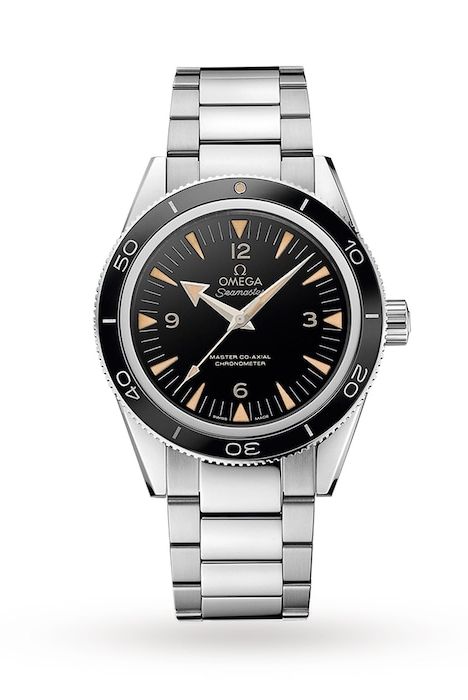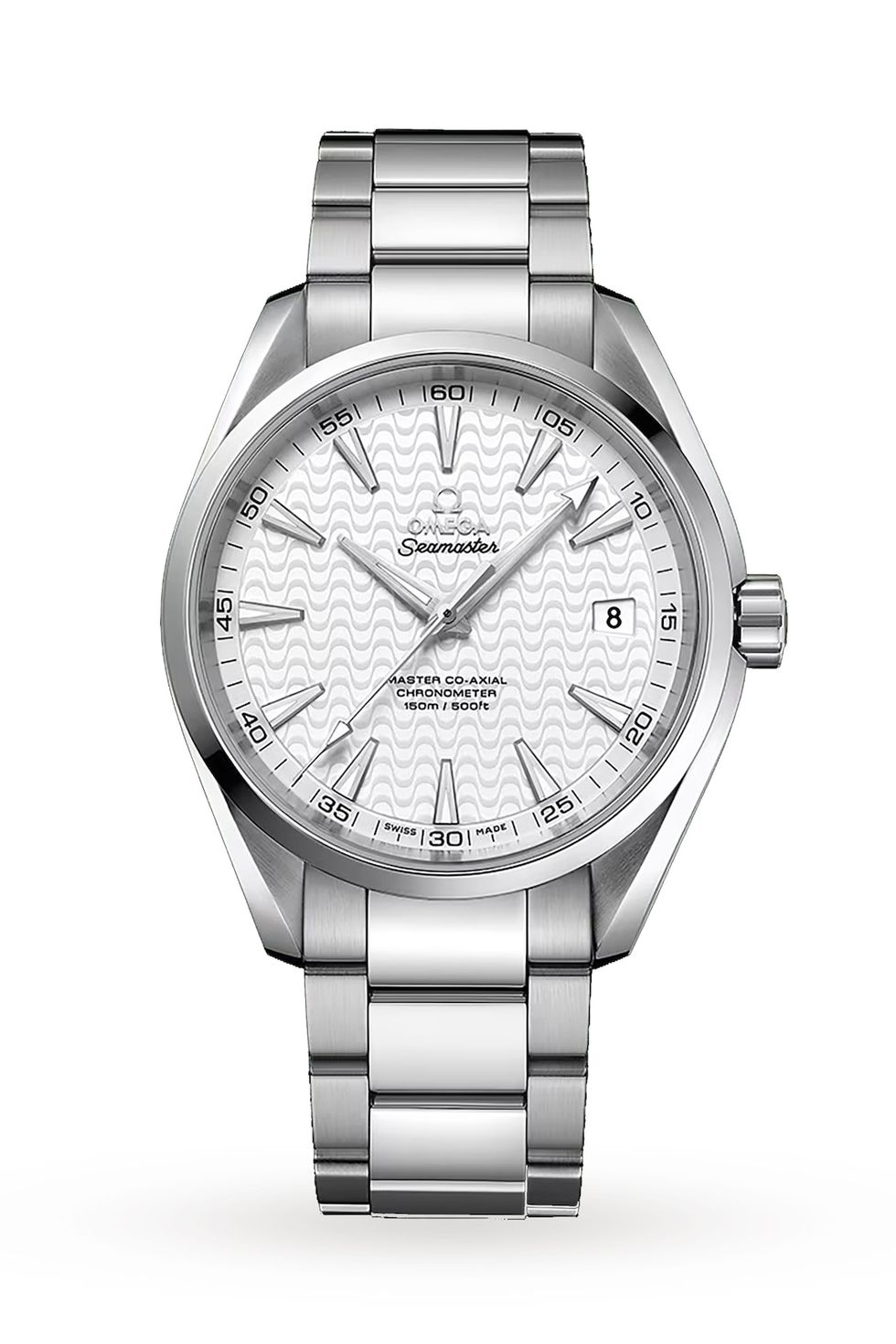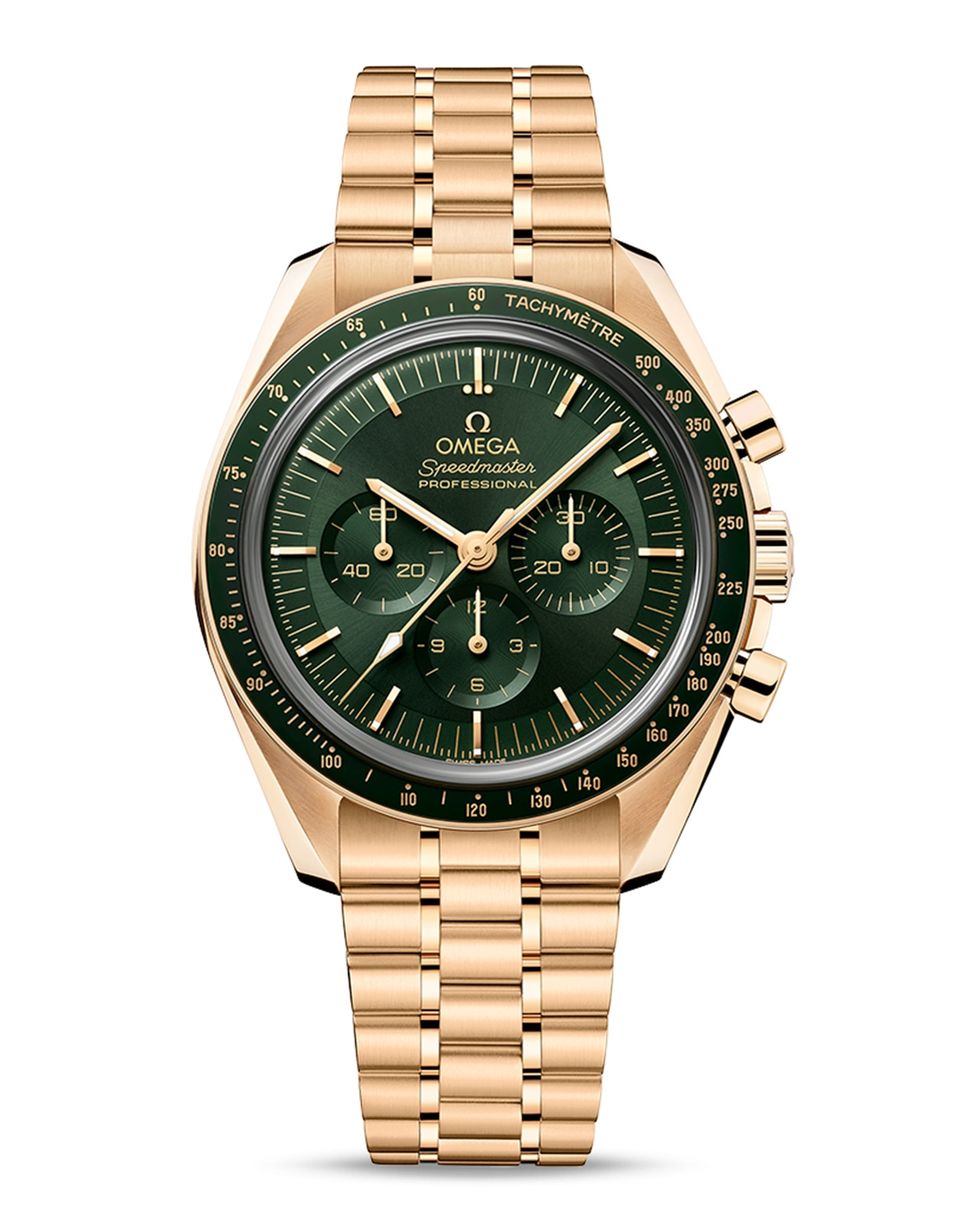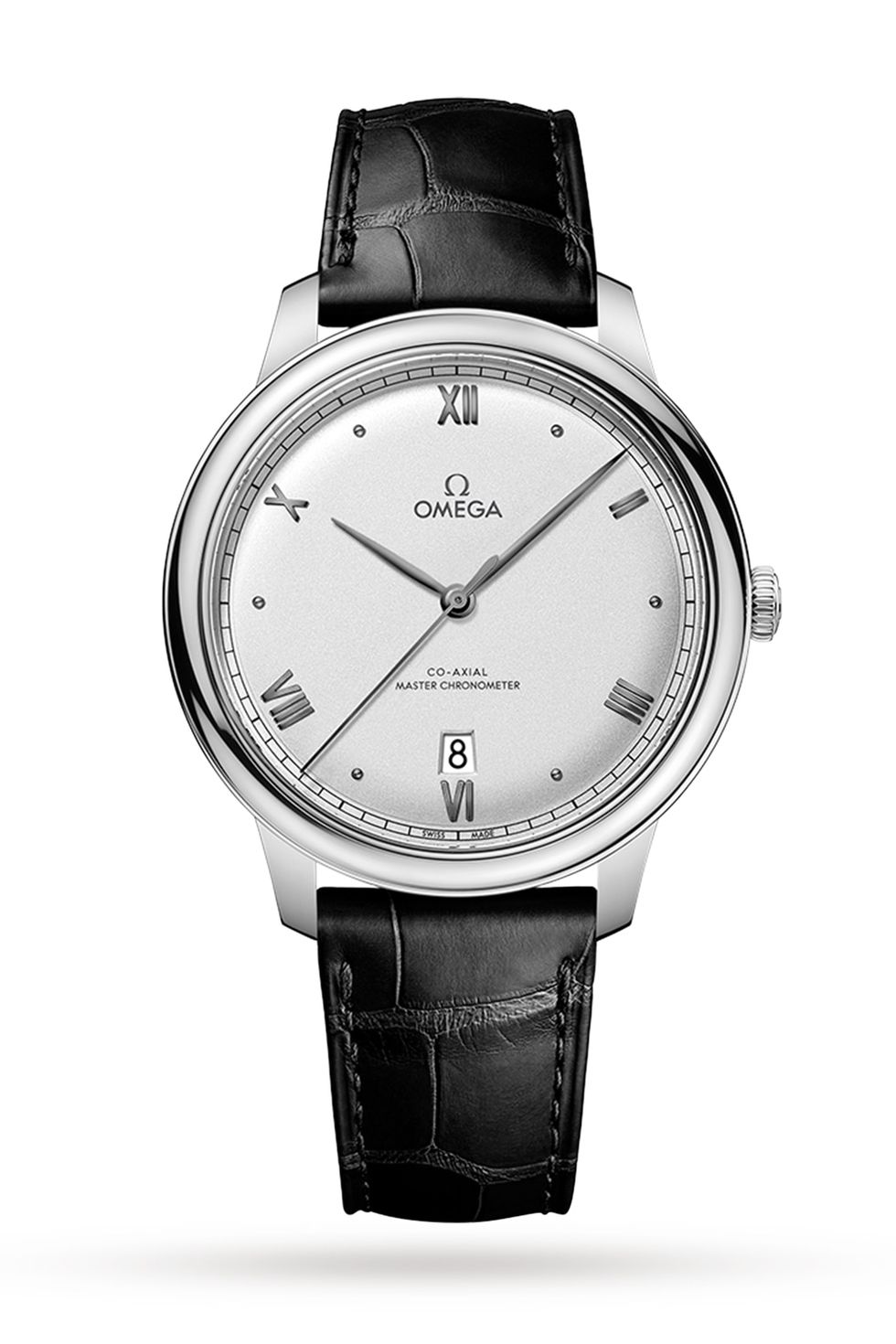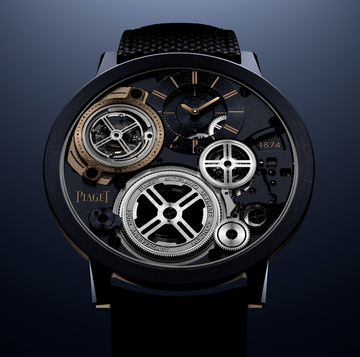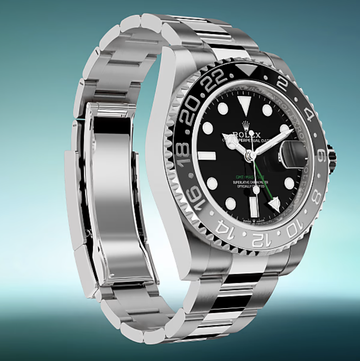You know Omega. It is easy for me to say that you know Omega, because you are reading Esquire and Omega is, at last standing, the world’s third-largest watch brand. But even if I were addressing you out of the blue, anywhere from Miami to Mumbai, I’d be confident in saying: you know Omega. Founded in 1848 in the Swiss town of La Chaux-de-Fonds by Louis Brandt, aged just 23, Omega is the powerhouse at the centre of Swatch Group, the world’s largest conglomerate of luxury watch brands. It is the official timekeeper of the Olympic Games; it is worn by George Clooney, Cindy Crawford and Nicole Kidman, and since 1995 it has appeared on the wrist of James Bond.
Perhaps you know it from the world of golf, where as well as gracing the left arm of Rory McIlroy it has sponsored both the PGA and Ryder Cup in the USA, and hosts its own pro-am tournament in the Swiss Alps every summer. Watch collectors know it first and foremost as the brand that sent its chronographs to the Moon, receiving space-flight certification from Nasa for the entire Apollo programme. As of last year, millions more now know it as the brand that lent this same famous design to its sister company, Swatch, to create the MoonSwatch. You might be justified in asking: after all this, is there anything about Omega that we don’t know?
Taken simply as the sum of its marketing campaigns, or its cold, hard, commercial figures, Omega might well present as a glossy luxury titan — which of course, it is, with production facilities as slick and devoid of imperfection as its computer-generated social videos. But that is only to scratch the surface. To jewellery-heads, it is home to Andrew Grima’s otherworldly creations of the early 1970s; devotees of military history will know it as the single largest provider of timepieces to the British armed forces in WW2; aesthetes will muse upon the weird and wonderful designs that peppered its late 1970s and 80s catalogues; and pilots, sailors and divers alike will admire its commitment to making watches suited to the extremes of our world. There is a charming, lovable side to the brand, too. I’ll bet you didn’t know, for example, that in 1909 it sponsored the Gordon Bennett Cup, a hot air balloon race created by the eccentric millionaire newspaper proprietor, in which the aim was simply to travel as far as possible from the starting line, in any direction, before being forced to land.
The question is: as Omega strives to be the world’s biggest and best watchmaker, is there space for it to be all of these things? Is a rich, deep history bursting with invention compatible with ruthless, relentless growth and global commercial success?
The websites of all luxury watch brands make soulless statements like “innovative watchmaking is the cornerstone of our heritage”, but in Omega’s case, it happens to be true. The company is named after a movement, a 19-ligne pocket-watch calibre introduced in 1894 and noted for its accuracy, easy maintenance and mass production. It was one of the first movements to combine time-setting and winding functions in a single crown, and the Brandt brothers — Louis-Paul and César, who ran the company after their father’s death in 1879 — were so proud of it they named it Omega, to underscore its status as the ultimate word in horological achievement. Hyperbole aside, the movement proved extremely successful, and the name stuck — as did the tendency towards innovation. Omega has produced the first minute-repeater wristwatch, the first tourbillon wristwatch and the first Swiss quartz watch. It pioneered water-resistant cases and, alongside Patek Philippe, was the only company to take part in every Swiss chronometry trial, where makers competed to produce the most accurate watches.
For a company more readily associated with iconic designs and globally renowned partnerships, it’s a redoubtable portfolio. “Omega has a much richer watchmaking legacy than Rolex — that’s beyond question,” says industry analyst Oliver R Müller. In recent years, Omega has redoubled its efforts to produce — for mainstream brands at least — the most technically adept, robust and resilient watches. In 1999, it adopted the work of genius watchmaker George Daniels, and introduced the coaxial escapement, an invention that dramatically improves on the performance of a watch in ways that are complex, obscure and almost certainly unlikely to make for stimulating dinnertime conversation. Escapements are so astonishingly finicky, so wildly hard to engineer, that no other company has ever industrialised at any scale an alternative to the lesser, but ubiquitous, Swiss lever escapement. Omega took the coaxial and, over the past two decades, used it as the foundation for an entire generation of movements. In 2015 it partnered with Switzerland’s national institute of metrology, METAS, to introduce a new certification process for what it calls “master chronometers”: watches that boast industry-leading levels of accuracy, magnetic resistance and everyday durability. At the launch, Omega was clear that the process was not proprietary — indeed, it invited other brands to follow suit. Deafening silence ensued, until this spring when Tudor, younger sibling to Rolex, announced that it too would put its watches through the master-chronometer certification. To close observers of the Rolex-Omega relationship, this felt like a chess move from Rolex: equip Tudor’s far less expensive watches with a stamp of approval that puts them on an equal footing with your opponent. Was Omega CEO Raynald Aeschlimann pleased that someone else had finally joined the METAS club? “I don’t want to say ‘pleased’ — for me the most important thing was that one of the brands of the Rolex group was considering [master-chronometer certification] as a new standard in the watch industry. Making that step was quite positive news for watchmaking.”
A certain degree of jostling with Rolex is a recurring undercurrent on planet Omega. Since 2015, Rolex’s “superlative chronometer” status gives its watches daily deviation of -2/+2 seconds; Omega’s master chronometers deviate between 0 and +5 seconds. Each argues that its own system is superior; Omega holding that it is better never to lose time than to lose or gain in a tighter window. The giants go toe-to-toe on materials, too: Rolex started calling its stainless-steel alloy “Oystersteel” in 2018; last year Omega introduced “O-megasteel” for the Planet Ocean Ultra Deep, a harder, more resilient alloy. Everose gold at Rolex plays Sednagold at Omega; Rolex’s “cerachrom” bezels face off against Omega’s ceramic with “liquidmetal” infill. The latest salvo from Omega comes in the form of the Speedmaster Super Racing, a proof-of-concept chronograph equipped with something called the Spirate system. A new escapement system with a silicon balance spring designed to enable high-resolution adjustment of the watch’s rate — down to increments of 0.1 seconds a day — it makes Daniels’ coaxial look like Duplo. I shall spare you the mechanical equations, but suffice to say the British Horological Institute described it as “a profoundly different idea that takes horology in a fresh direction, impossible with previous manufacturing methods”. Aeschlimann adds animatedly, “It’s getting into the next generation of rating, of precision. It’s incredible to see that you can invent… what we all want, which is precision on an industrial basis. It was a long development, and a very big launch, because everybody knows this is the heart [of things] and that it is also very, very difficult to get.”
The Spirate — a blend of “spiral” and “rate” — should eventually appear across Omega’s range, as did the co-axial escapement before it, although Aeschlimann demurred when pressed on whether such technological advances would, or should, find a home on Omega’s most revered model, the Speedmaster Moonwatch Professional. As a totemic reference for the brand, this chronograph’s slow evolution embodies the tension at the heart of Omega: like many Swiss watch brands, it relies overwhelmingly on its heritage, yet asserts its excellence via high-tech achievements and cutting-edge materials science. Since the Speedmaster’s use by Nasa and the careful nurturing of a fanbase around the space-going chronograph, the watch has held a special place for Omega fans, and attempts to modernise it are met with dismay in collector circles. The Speedmaster eschews a sapphire crystal glass for the original hesalite, and is hand-wound — a fundamental property given that automatic chronographs only arrived in 1969. But it has, in 2021, finally been given master-chronometer status and surely, before long, will join the Spirate ranks. Why should it matter? Don’t we all want, as Aeschlimann says, precision? It’s up for debate: anyone buying into the legend of the only watch to have been worn on the Moon surely wants the soul of that 1960s watch to remain. Add too much technology and you risk diluting that legacy.
Omega’s vast headquarters, overhauled in 2017 by Japanese architect Shigeru Ban, are — like most large watchmakers’ premises — quiet, spacious and pristine. There is an abundance of bare timber in the triple-height lobby, but the working spaces are cold, hard, clean and industrious. At the building’s centre sits a roboticised archive of parts, the central nervous system of the supply chain and production line. This may be where Omega’s beating hearts are assembled, but its soul lives across the road, in another Ban creation, the grandly titled Cité du Temps, unveiled in 2019. Resembling a colossal invertebrate that has crashed gently onto north-east Biel, it houses Omega’s museum. Today, if you want to play at watchmaking’s top table, you invest in a gleaming, multimedia-enhanced shrine to your own past, and Omega’s is one of the best. Nixon’s gold Speedmaster; JFK’s rare dress watch; the early Marine water-resistant cases, “flown” Speedmasters, prototype dive watches, military pieces and countless other artefacts of horological history are here. If your product line-up is founded on designs that began life in the 1940s, 50s and 60s, a well-kept archive is an essential part of the storytelling.
Concomitantly, brands are highly attentive to the vintage market. It is no secret that the top watch companies are active at auctions, working hard to build up the mythos surrounding their rarest and best-loved vintage models, understanding that a devoted lobby of connoisseur collectors can pay dividends on the high street. Omega’s presence in the vintage market — one area in which it trails Rolex significantly — has steadily risen over the last decade, which has seen the first Omega to sell for more than a million dollars.
In the vintage watch market, authenticity, provenance and condition are the holy trinity, and the staff in a brand’s museum, entrusted with cherishing its history, are the final arbiters of truth (in an often murky environment) and de facto custodians of the brand’s reputation. All of which makes it highly embarrassing that, earlier this year, Omega found itself at the centre of the biggest scandal to hit the vintage-watch world in decades. After investigations first from independent blogger Jose Pereztroika and then the Neue Zürcher Zeitung newspaper, it was claimed that at least three Omega staffers, including the former museum director, another employee in the heritage department, and his father, a top-level executive at the company, were involved in a scheme to defraud the company of more than £2.7m. Working with outside associates, it was alleged they had conspired to create a “franken-watch” — a vintage watch comprised of a hodge-podge of parts that is claimed to be as-new and original — and submitted it for auction at Phillips in Geneva. Having forged components and created bogus paperwork that attested to the watch’s originality, they allegedly used at least two co-conspirators to bid on the watch, driving the price higher than anyone thought possible for an Omega, even a rare Speedmaster in unusually desirable condition. In a statement issued at the time, Omega said, “Omega and Phillips were the joint victims of organised criminal activity involving the selling of this specific watch by auction. … Omega is bringing criminal charges against all involved.” At the time of writing, criminal proceedings were still ongoing. Given the nature of the scheme, many have questioned whether it could credibly be an isolated incident. “It was a big wake-up call, for sure,” says former Christie’s watch expert and vintage dealer Eric Wind. “It’s unfortunate it happened; it’s good people are aware that it can happen, and to proceed with caution when buying important watches.” Mr Aeschlimann concurred that it has “brought [a] spotlight on part of the industry, a big part of the business, that was maybe not always in the spotlight”.
What the fallout will be, at Omega and beyond, remains to be seen, but for now its fortunes are undimmed. Crucially, Omega is adept at keeping the spotlight just where it wants it, and is not short of razzmatazz with which to sell its scientifically advanced creations to the world. Consider, for example, the Speedmaster Chrono Chime. Launched at the end of 2022, it is a remarkable combination of minute repeater and high-frequency chronograph, resulting in a watch that can measure time to 1/10th of a second and then ring off that measurement with a finely tuned peal of its miniature gongs. It is, at £365,000, the most expensive watch Omega has ever retailed, the most complicated movement it has ever designed (and yes, it’s a certified master chronometer), and it was revealed not in Switzerland but at the Walt Disney Concert Hall in Los Angeles. Omega has also flexed its muscle on the Hollywood red carpet over the past few years, paying to place its watches on stars’ wrists at the Oscars and other high-profile events — signs that Omega has its sights set on the kind of visibility enjoyed by Rolex and Cartier.
Back on the topic of the Chrono Chime: “We like this kind of challenge and we are good for many years in terms of orders,” says Aeschlimann. As to why in the world Omega is making half-million-dollar extravagances, he refers back to the fact that Omega worked on the first-ever minute repeater for the wrist. “Of course, it’s a world where some other brands are [already], but it was still very well accepted, because it was linked with our DNA. It shows our commitment to watchmaking, and it shows that we’re able to push boundaries.” With the most rapid growth now occurring in the highest price bracket of the watch industry, and seemingly no limit to the appetite of billionaire collectors for new marvels, does it signal that Omega intends to shift its focus to the ultra-high-net-worth market? “No. No, no, no,” insists Aeschlimann. “It signals that we have this ability, that we can deliver this kind of a wow effect, but it is not our strategy to go there.”
The wow factor was in evidence this summer too, as Omega decamped to Mykonos to mark the 75th anniversary of the Seamaster. There, having left the physics textbooks at home, it unveiled a collection of 13 references within the (vast, some would say overgrown) Seamaster family. Each had a blue dial, tinted lighter or darker depending on the watch’s water resistance: pale blue for a 150m-rated Aqua Terra; mid-blue for the hero Diver 300M and a blue-black gradient for the Seamaster Planet Ocean Ultra Deep, which will happily plunge to a depth of 6000m. The whole thing was neat, masterfully choreographed and perfectly on-trend, which naturally led to a fair degree of whining that in focusing merely on colour rather than engineering (for once), Omega had sold out to the fashionistas. It’s not true; only last year, Omega was scrapping with Rolex over whose watches could dive the deepest. Rolex, with James Cameron, reached a depth of 10,908m in 2012; Omega topped that in 2019 when explorer Victor Vescovo took his submersible, complete with prototype watch, to 10,928m. Then, in 2022, Omega commercialised the design in the form of the Seamaster Planet Ocean Ultra Deep (depth rating: 6000m), only for Rolex to produce the Deepsea Challenge, rated to 11,000m — deeper than any point in the Earth’s oceans. Point made.
But away from the willy waving, the whiners have the kernel of a point. To compete in today’s landscape, a certain “fashionification” might be inevitable. The watch industry has undergone a rapid transformation in the past two years, with faster product cycles, an explosion of limited-edition pieces, an enormous diversification of colour and style and, most obviously of all, an obsession with collaborative design. Has Omega got what it takes to navigate these waters? In contrast with its competitors at LVMH, but also more nimble independent brands, the Swatch Group cohort has been reluctant to enlist outside designers or to partner with brands in other industries.
Aeschlimann, eager to disavow luxury as a concept — “I hate this word” — recognises that watches have learnt rapidly from fashion, particularly in relation to “consumer experience”. But he is bullish on collaborations, saying “we’re not really into finding a way to [raise our profile] by adding a collaboration. For me it has to be totally added value. If you are just making one plus one equal two, that doesn’t make any sense for me.”
Another trend from which Omega has been conspicuously absent is the communal adulation of designer Gérald Genta, who created such icons as the Audemars Piguet Royal Oak and Patek Philippe Nautilus. So it’s surprising Omega hasn’t felt the temptation to move the focus to the Constellation, which Genta is known to have worked on, and leverage the connection for all it’s worth. “We know that Gérald Genta has done an incredible design for Omega, as he has done for a lot of brands,” says Aeschlimann. “But Omega today is more important. We are lucky to have the four biggest lines, but we are also balancing the evolution of each and every line. If we remade everything people ask us to make, we would have a brand that, as you see in some of our competitors, is slightly losing their identity in terms of the key bestsellers.”
On the subject of brand identity, it would be impossible to ignore the launch last year of the MoonSwatch, Omega’s seismic collaboration with sister brand Swatch that borrowed Speedmaster DNA and fused it into affordable, colourful, hype-tastic Swatches. It was a runaway sales success, but much of the feedback from the Omega faithful was that it cheapened the brand; not what you want to hear while you’re chasing Rolex. Perhaps with this in mind, Aeschlimann emphasises that the MoonSwatch is “very much a Swatch property”, but he also highlights the impact it had on his brand. “The Speedmaster had its best-ever year last year: we sold twice as many watches as we’ve sold before. There have never been so many new customers in our own stores, wanting to know more about the Speedmaster and its history.” In early September, the Swatch Group lifted the lid on a collaboration with Blancpain, the Blancpain x Swatch Scuba Fifty Fathoms, hoping to pull off the same trick again.
According to an annual Morgan Stanley report, Omega produced an estimated 560,000 watches in 2022, giving it an implied market share of around seven per cent. Rolex, the report concludes, had a 29 per cent market share. “Of course it’s their dream one day to catch Rolex,” says Müller. “At the beginning of the 70s, Omega was number one and Rolex was behind. It’s not that things can’t change over time. But Rolex has managed over the last 50 years to build up such a strong brand. When you have so much positive momentum, when your brand is growing much faster than the market, for the challenger it becomes very difficult to catch up.”
You can’t say Omega isn’t putting the effort in. It’s hard to think of another mainstream brand that pushes as hard on a technological front, and by adding a healthy measure of showbiz glamour to sit alongside its core strengths of James Bond, the Olympics and Nasa, Omega has become the full package. At times, the upward acceleration can risk nosebleeds — Müller points out that the brand’s average sale price has tripled in the last two decades, and counsels that “you have to be very careful not to go up too fast, not to lose your natural clients” — but, seven years into the job, Raynald Aeschlimann shows no sign of slowing down.
Closing the gap on Rolex might be the target, but fans of the brand will want to know that it can be done without neglecting the less tangible qualities that differentiate Omega from the alpha brand in Geneva. Because regardless of what the league table says, for its followers, Omega might already be what its founders hoped 129 years ago. The last word in watchmaking.

